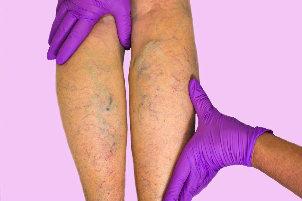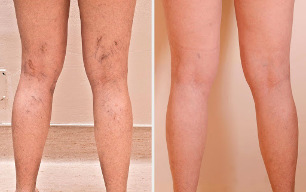It is a chronic disease of the veins, which is characterized by a thinning of their walls, the extension of the light, as well as the formation of nodes. Common in 40% of women and 20% men.
It is a dangerous disease, mainly because of its complications. When a bad or a case of failure of the treatment is to develop these terrible of the state, such as thrombosis and thrombophlebitis, and bleeding from the varicose veins. Thrombosis (total or partial closure of the lumen thrombus of the vein) or thrombophlebitis (inflammatory disease of the wall of the vein thrombosis) arises suddenly, is not related to physical exercise. The swelling spreads rapidly on the lower member and is accompanied by an arching of the pain. Redness or blue, the pain of the skin. In the case of the separation of a blood clot, with a current of blood, it enters the blood vessels of the lungs, and in the case of a total or partial closure of the container is capable of causing serious disease - a pulmonary embolism. This complication is often fatal. In cases of suspicion of data complications, you should immediately take a horizontal position, lift the leg up, through telephone contact with the doctor. When the lesion in the area of the dilated vessels can occur bleeding. In this case, the urgent need to impose a leg over the seat of the bleeding beam (medical or improvised), quite strongly, that the bleeding has stopped of emergency and call an ambulance.
Thrombosis (total or partial closure of the lumen thrombus of the vein) or thrombophlebitis (inflammatory disease of the wall of the vein thrombosis) arises suddenly, is not related to physical exercise. The swelling spreads rapidly on the lower member and is accompanied by an arching of the pain. Redness or blue, the pain of the skin. In the case of the separation of a blood clot, with a current of blood, it enters the blood vessels of the lungs, and in the case of a total or partial closure of the container is capable of causing serious disease - a pulmonary embolism. This complication is often fatal. In cases of suspicion of data complications, you should immediately take a horizontal position, lift the leg up, through telephone contact with the doctor. When the lesion in the area of the dilated vessels can occur bleeding. In this case, the urgent need to impose a leg over the seat of the bleeding beam (medical or improvised), quite strongly, that the bleeding has stopped of emergency and call an ambulance.
The weakness of the muscular layer of the venous wall and the failure of the valve of the device become for the reason that, under the influence of the action of the muscle pump," the blood begins to flow in the opposite direction, towards the bottom. This leads to an increase of the pressure on the walls of the blood vessels, the continuation of the progression of the insufficiency of the valves, the expansion of the lumen of the veins and the formation of nodes. The muscle fibers of the vein wall atrophy, disrupted the nerve receptors governing the venous tone, which, in turn, further strengthens the manifestations of the venous insufficiency. The risk factors of the disease are: genetic predisposition, pregnancy, obesity, the daily life of a long stay in a sitting or standing position, activities related to lifting heavy objects, systematic, wearing tight clothes, corsets, poor diet, lack of content in the diet of dietary fiber and vitamins, the violation of the hormonal status.
The clinical manifestations
The main visible sign of the varicose vein disease - BAG or cylindrical extension of the surface of the vein. Varicose veins on the legs become branched, projecting above the surface of the skin on the legs and feet. Maximize the varicose veins are expressed after heavy or long exercise. At the beginning of the disease concerned about fatigue, a feeling of heaviness in the legs, burning, bursting, the severity of which is maximal after a physical effort. Can occur in ephemeral swelling, a throbbing pain over the vein. The timely treatment to a specialist even at an early stage will prevent the further development of the disease. During the progression of the disease is comprised of chronic venous insufficiency.
The diagnosis of varicose veins
The "gold standard of diagnosis is considered, an ULTRASOUND of the veins of the lower extremities, in which are defined the affected areas of the vein. On this, in principle, on the anatomy and classification of the varicose disease, indicating altered the container. For example, the defeat of the great saphenous vein above or below the knee, the small saphenous vein. When the questionable data non-invasive methods have resorted to surgical methods of the study, for example, by intravenous angiography (intravenous injection of a contrast medium for the assessment of the state of the venous system).
The treatment of varicose veins
Non-surgical treatment of varicose veins of the lower limbs gives good results as in the beginning of the disease, when the skin manifestations not pronounced and only moderately reduces the work capacity.
It is a surgical disease, complete healing of that is only possible after a rapid processing:
- Phlebectomy - the rapid removal of varicose veins-scope of vienna. The objective of this operation is to eliminate the disease of reset of the blood by the removal of the base of trunks of large or small saphenous vein, so that ligation of the communicating veins. There are several types of operations. They apply almost always, even in complex cases. In all these methods is the deleted part of vienna, which was struck, and the segments of vienna are registered. Vienna, as if to gently exfoliate, and is not cut tissue, which also reduces the operating system is injured. The same thing occurs when the use of the surgical technique, and, in addition, which is less bruising, because of the cold spasm of reduce bleeding.
- The hardening - introduction to the extent of the vein of a specific substance (sclerosant) which causes "sticking" to the wall of the vein with the stopping of the blood flow in it. A result of lack abnormal discharge of blood, eliminates cosmetic defects, such as vienna disappear and becomes invisible. Sclerotherapy is effective only when the expansion of the small branches of the base of the trunks, which limits its use during the great expressiveness of process. The advantage of sclerotherapy is the lack of scars, the need for hospitalization. After sclerosing veins particular rehabilitation is not necessary.
- Laser Photocoagulation - a method based on the destruction of the vein wall by a hot, laser, resulting in a "spike" of the venous lumen. Shows only during the expansion of vienna is not more than 10 mm of the Method related to the conduct of anesthesia. Cosmetically is preferable, but as after the deletion of vienna requires early activation of the patient and long-term elastic compression.













































